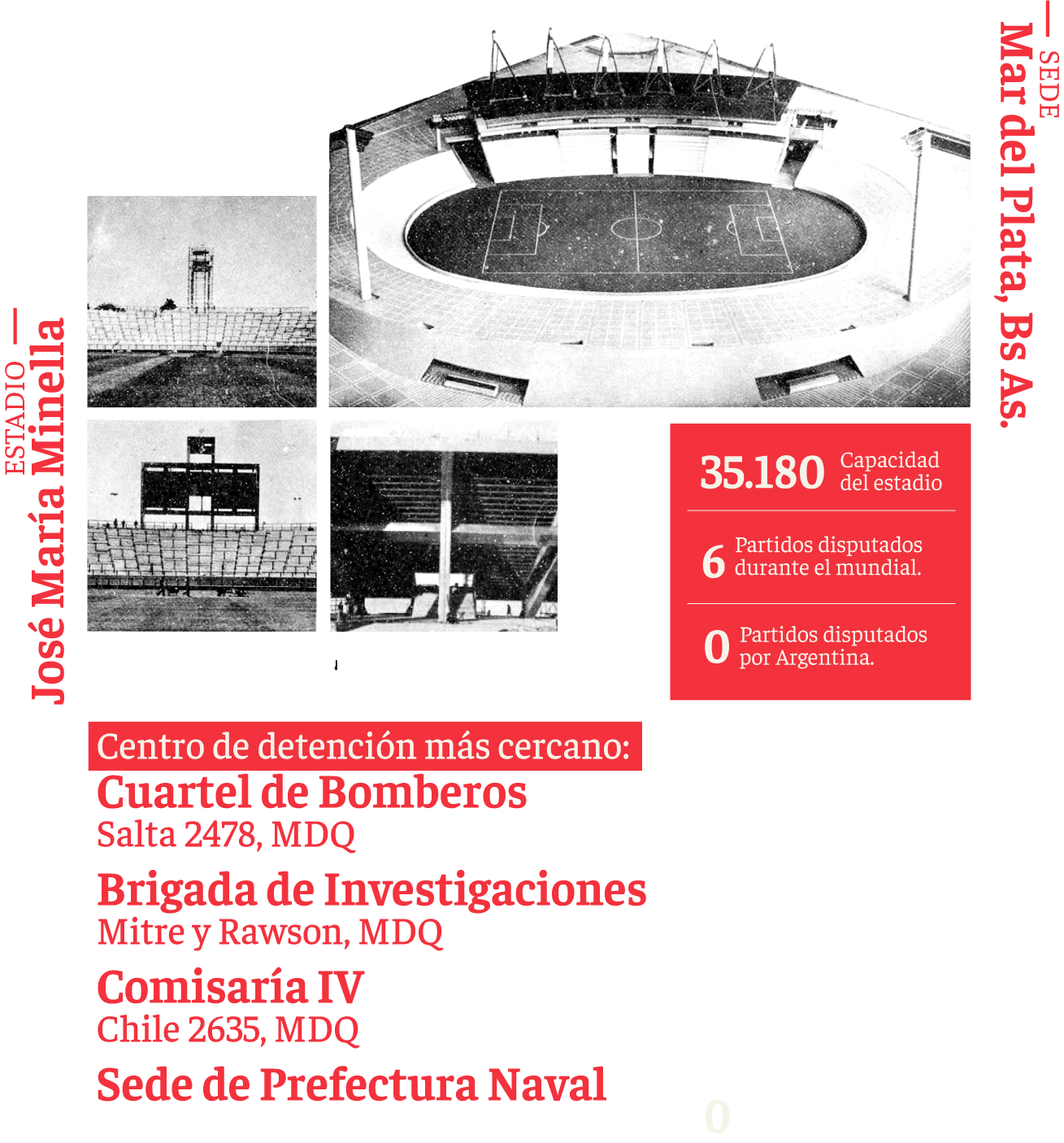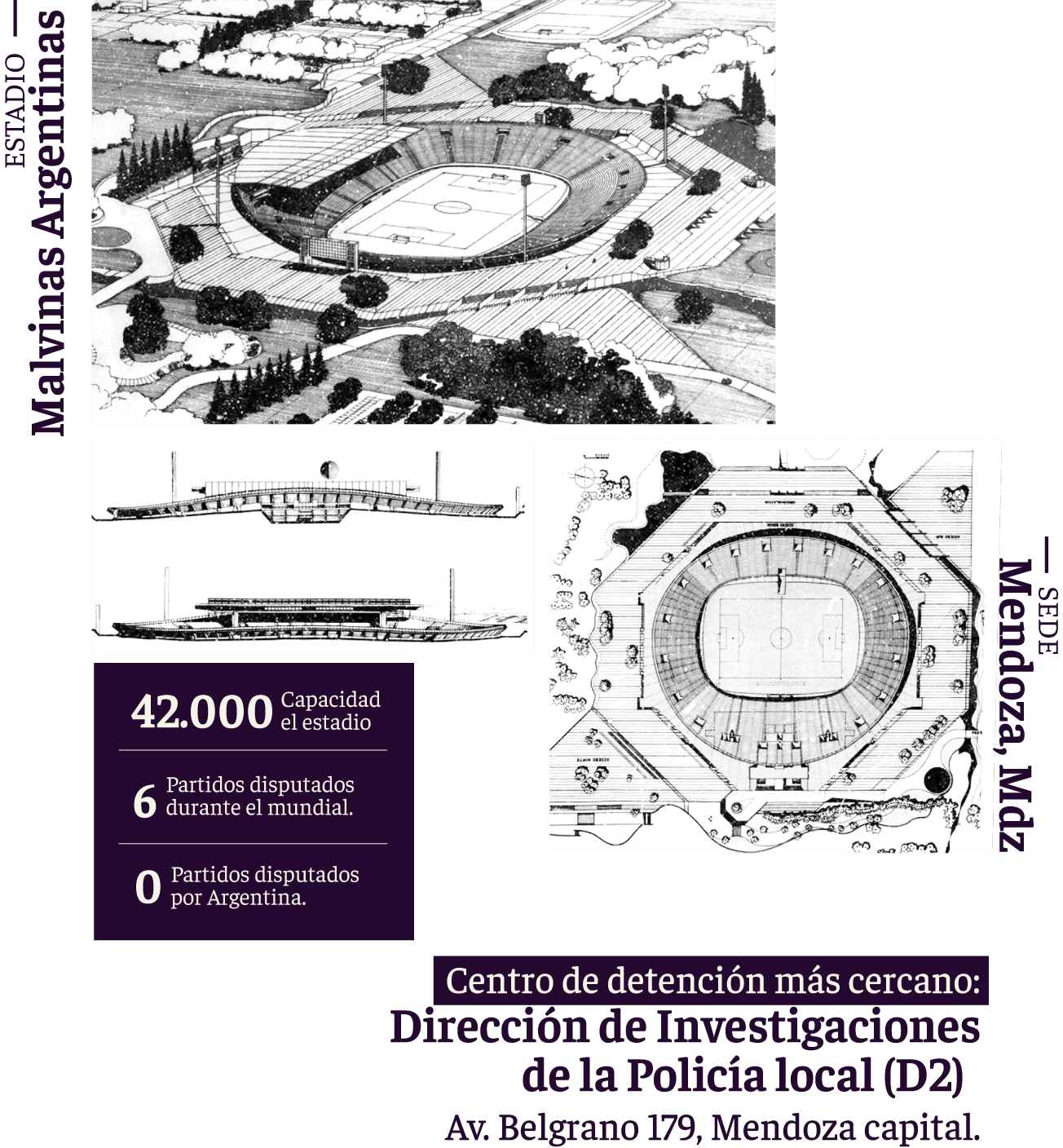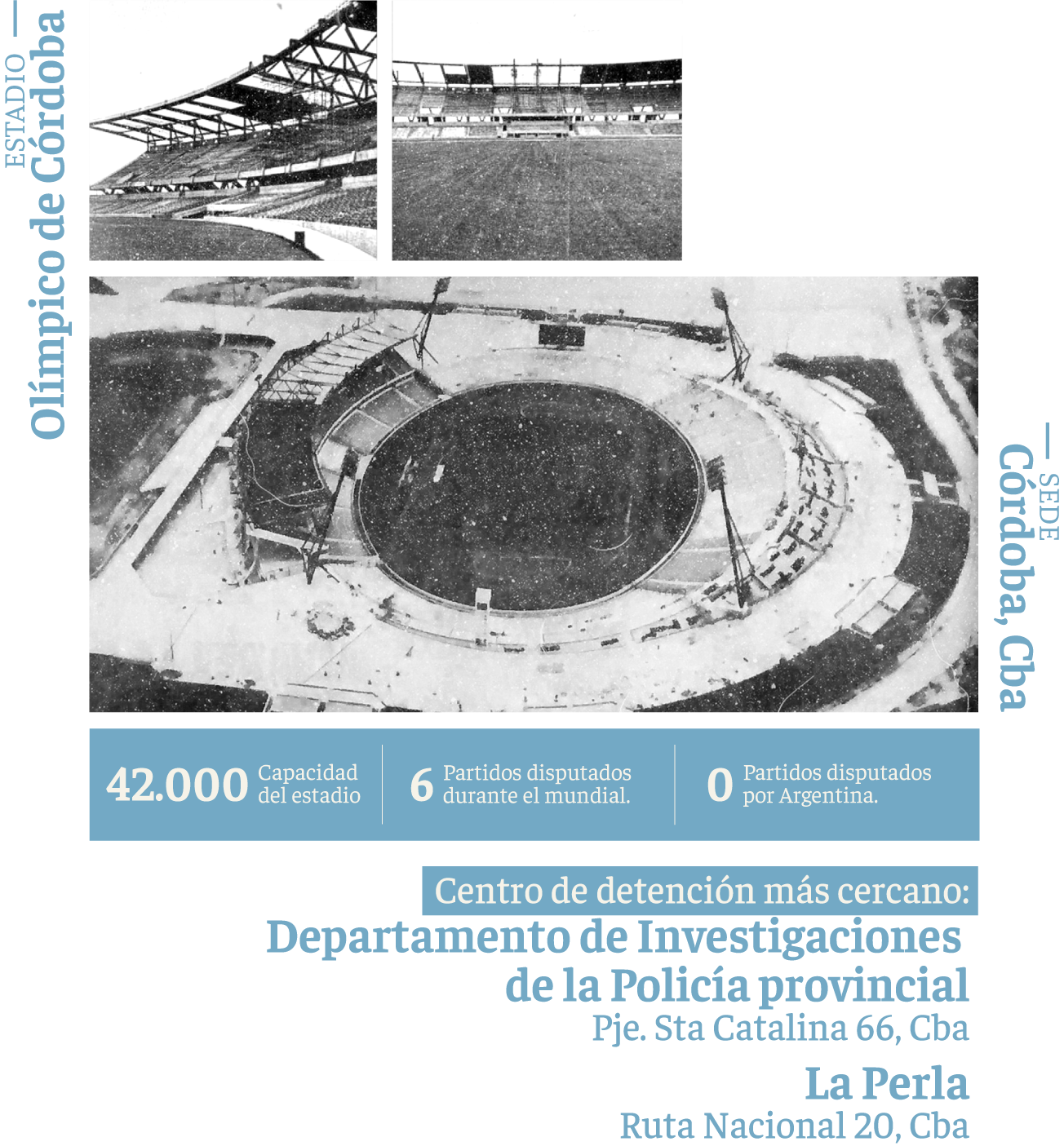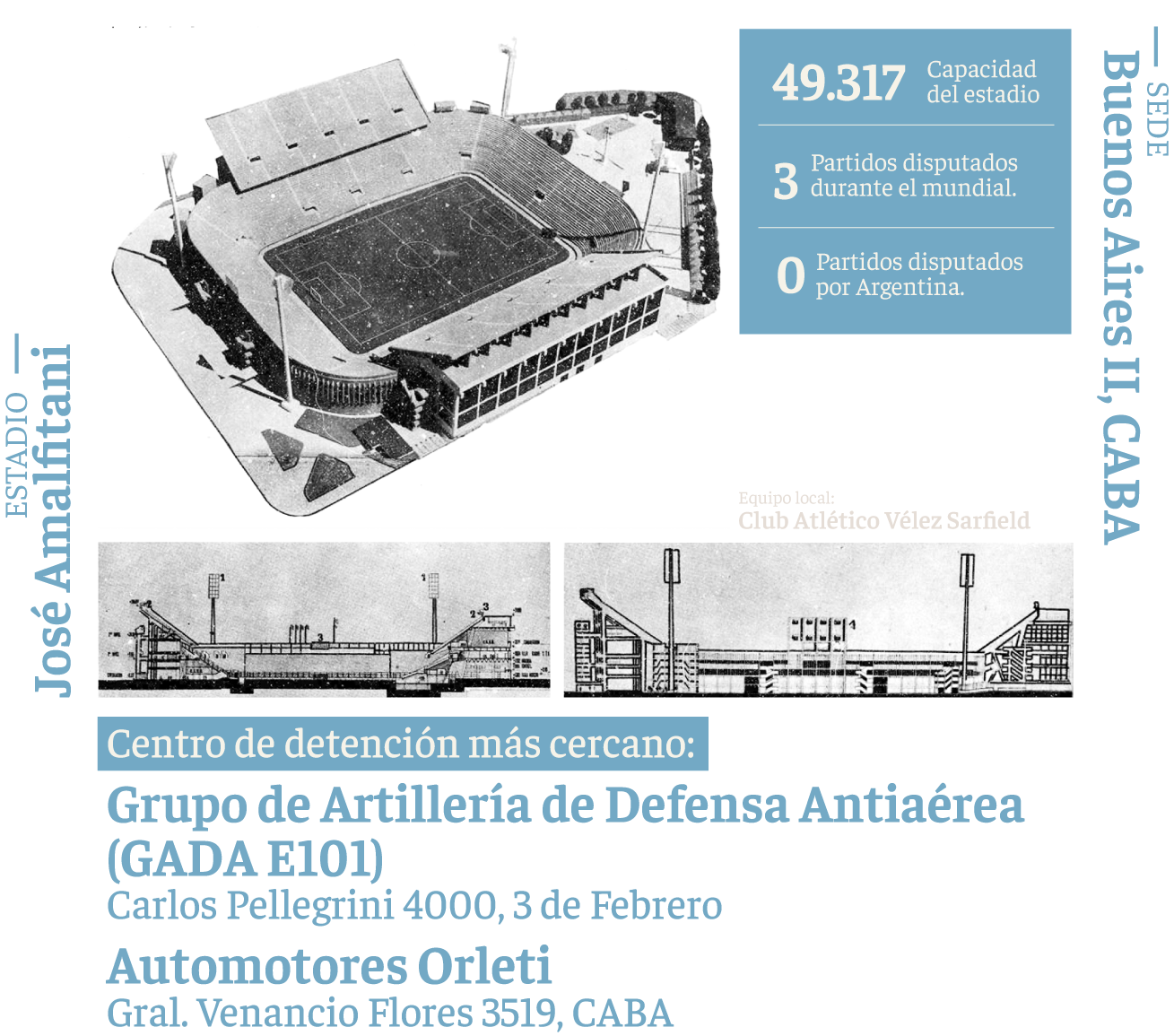There were six stadiums for the 78 World Cup. Six venues distributed in four provinces: Buenos Aires, Santa Fe, Córdoba and Mendoza. All of them were surrounded by clandestine detention centres in which victims of the crimes against humanity committed by the last civic-military dictatorship were kept before, during and after the championship. The 1978 World Cup Autarchic Entity (Ente Autárquico Mundial, EAM) remodelled the River Plate and Vélez Sarsfield stadiums in Buenos Aires City; Rosario Central’s in Santa Fe, and ordered the construction, specially for the occasion, of another three: the José María Minella stadium, in Mar del Plata; the Malvinas Argentinas stadium, in the city of Mendoza, and the Chateau Carreras, in Córdoba. These tasks contributed to the elevated budget destined for the world championship, which managed to reach 520 million pesos.
Mar del Plata - José María Minella stadium

The world cup stadium of Mar del Plata was built by the companies Sebastián Maronese e Hijos and Crivelli Cuenya Construcciones. According to the book El mundialista, by Juan Carlos Morales (2004), the works began in October 1975 in an area of the Municipal Sporting Complex “Teodoro Bronzini” (760 de las Olimpíadas Avenue, Peralta Ramos Oeste, Mar del Plata, Buenos Aires) and it’s capacity, according to official records, is of 35,180 seats distributed amongst north and south stalls, with concrete stairs; and another area of covered and uncovered stalls, with numbered seats and a box.
The “José María Minella”, named after the football player and coach born in Mar del Plata, is located approximately 20 blocks from, at least, four clandestine centres of detention that operated in the city during the last dictatorship: the Fire Station (Salta street, between Gascón and Alberti), the naval prefecture headquarters, the Investigation Brigade (streets Mitre and Rawson) and the IV Police Station (Chile street 2635).
The field was opened in May 1978 with a match between the Mar del Plata local team and a combination team from Tandil. The marplatense paper La Capital spread the event as “a holiday in the city”, “the dreamt day”. And described the stadium as “magnificent” and “yet another challenge met”. Like most media of the time, La Capital was an uncritical reproducer of the voice of the then reigning voice of the dictatorship. In spite of the compliments, not everything went according to plan. During the championship there were some problems with the grass. Somos magazine informed that the turf had peeled off during every one of the first round’s matches. The chief of the stadium, colonel Raúl Brisso, blamed the humidity. “Never since 1904 has Mar del Plata been so humid” he excused himself.
During the Football World Cup of 1978 six matches were played in the José María Minella stadium: three of Group 1, integrated by Italy, France, Hungary and Argentina; and three corresponding to Group 3, composed of Austria, Brazil, Spain and Sweden. Out of these eight teams, Argentina was the only country that didn’t have to play in that field. Brazil, on the other hand, played three games in it. The time of the year and the closeness to the sea made Mar del Plata a particularly humid and cold place during the winter. There were no games played before 2 pm. In spite of this, as Morales said in his book, the country specifically asked for the Mar del Plata venue.
Mendoza - Malvinas Argentinas stadium

“Malvinas Argentinas” is located in the heart of the General San Martín Park, one of the tourist attractions of the capital city of Mendoza, because of its location at the foot of the Andes. With capacity for around 42 thousand spectators, its construction, left under the charge of Uruguayan architect Rafael Viñoly, started in 1976 and ended a very short time before the beginning of the world championship. Only four kilometres from there, in the direction of the centre of the provincial capital, operated the main clandestine centre of detention and extermination in all of Mendoza, the Direction of Investigations of the local Police, better known as D2. Today, the place, in Belgrano Avenue 179, was reclaimed as a site of memory.
Besides the main stadium, the works for the 78 World Cup included a training field, the construction and repairing of routes and ways to get to and out of the property, and the remodelling of the city airport and its parking lot. The initial budget with which they counted, according to newspaper articles, was of almost 61 million pesos.
The name that it has kept up to this point was assigned in 1982 in reference to the armed conflict that Argentina was involved in along with the UK over the southern territory. Up until then, it was called “Ciudad de Mendoza” (Mendoza City). It was opened on May 14th, 1978, with a match between Mendoza and San Rafael teams.
Argentina didn’t play in that venue during the 1978 World Cup either. The Netherlands, Iran, Scotland and Peru, Group 4 of the Cup, were the ones to dispute positions there during the first round. In the second round, Brazil and Poland were added.
Córdoba - Mario Alberto Kempes stadium

The Mario Alberto Kempes is one of three stadiums that were born for the 78 World Cup. It was built in the natural reserve of Chateau Carreras, about 10 kilometres from the city of Córdoba, capital of the province. That’s the reason it is known as the “Chateau Carreras”. Its original name was Córdoba Olympic Stadium, but after the championship it was renamed with the name of the Cup’s top scored.
Its construction began in 1975 and was in the hands of the architectural studio Sánchez Elía Peralta Ramos, located in Buenos Aires, in society with the cordobés architects Hugo Oviedo and Alberto Ponce. The architects Pedro Facchin and Luis Marchesini also collaborated in the works.
Just as in Mendoza, in Córdoba the works linked to the 1978 World Cup exceeded the construction of the stadium itself. The EAM coordinated the emplacement of a highway uniting the city of Villa Carlos Paz with the capital city. According to Ana Mariani and Alejo Gómez Jacobo in the book La Perla, the way was built in terrain donated by the 3rd Army Corps to National Road Administration who, in exchange, promised the construction of a “little house” on the right wing of the route, “metres after the bridge that takes you to Malaguer”, informed Carlos Pez, an engineer for one of the compmanies that was in charge of building the highway.
This “little house” became, a short time after, the biggest clandestine centre of detention in Córdoba and one of the most terrible exponents of State terrorism in the country. The stadium is located 15 metres from that chupadero and another 15 from the ex Department of Investigations of the provincial Police, that also operated as a clandestine centre of detention and extermination during the last dictatorship, in Passageway Sta Catalina 66.
According to official records, the stadium could hold, after its inauguration in May 1978, almost 48 thousand spectators. Decades after it was remodelled, and its capacity expanded almost 10 thousand seats. A month before the 78 Football World Cup, the Argentine National Team and a team of players of the province came to première the playing field. It was the only time the national team set foot on the flaming new stadium, seeing as they didn’t play a single match there from the championship that they ultimately won.
The “Chateau” was venue of Groups 2 and 4 during the first round, scenario of the matches between Federal Germany, Mexico, Tunisia, Peru, Scotland and Iran. The first of them received a visit from dictator Jorge Rafael Videla, who saw Peru win against Scotland 3 to 1. In the second round of the World Cup, the countries that played in the stadium were Federal Germany, Netherlands and Austria.
Buenos Aires City - Vélez Sarsfield Stadium

The “José Amalfitani” stadium, located in the porteño neighbourhood of Liniers, was one of the three remodelled in the context of the 78 World Cup. At the beginning of 1977, the 1978 World Cup Autarchic Entity was in charge of the property, that remained “under sconstruction” until May of the following year. During this time, Vélez played their home games in the Ferro stadium.
The main works consisted on the construction of new stalls in the southern gallery of the Stadium, a stand in the upper area and the collocation of seats on the lower level. Besides this, an electronic board was put over the east stand (the same board that was placed in the other five world cup stadiums), the Stadium was equipped with an electricity generator, the grass was conditioned and the lighting system was improved, among other small modifications.
The expenditures for all of these upgrades were absorbed by the club through a mortgage that it paid for the following 20 years. The first fees, in the 80s, were of over 350 million pesos. The work was under the responsibility of architects Antonio Perez and Ricardo Staricco, and engineer Rodolfo Bramante.
The stadium was reopened on May 23rd, 1978, with a friendly match between Vélez and All Boys. During the World Cup, three games were played between teams of Group 3. Austria, Spain and Sweden. It’s located less than 5 kilometres of at least three ex-clandestine centres of detention: the Artillery Group of Anti Aerial Defense (GADA E101) of Tres de Febrero, in the Buenos Aires province (between the streets Carlos Pellegrini, Yrigoyen, Comesaña and Reconquista); Automotores Orletti (Gral. Venancio Flores 3519, CABA) and El Olimpo (Coronel Ramón Lorenzo Falcón 4250, CABA) where José Poblette, his partner Gertrudis and their baby Claudia were held captive.
Ciudad de Buenos Aires - Estadio de River Plate
El Monumental was the main venue of the 78 World Cup. There was where the championship was inaugurated, the first game was played and where Argentina won the final as well. River Plate’s stadium was one of the three remodelled for the World Cup.
The stadium, located in Núñez, was the most used during the World Cup that the dictatorship of Rafael Videla, Emilio Massera and Orlando Agosti organised. Argentina played four games there, including the final, and teams such as Federal Germany, Poland, Hungary, Netherlands, Italy and Brazil also competed in it. A few blocks from there, before the 78 World Cup, during it and after it, operated one of the biggest clandestine centres of detention of the terrorist State, the Higher School of Mechanics of the Navy (Escuela Superior de Mecánica de la Armada, ESMA).
The costs of the remodelling work were split between the club and the State. In August 1976, the institution announced a first deal with the EAM to begin on the works that would cost the club a total estimated final amount of 130 million pesos and 110 million extra that would be paid by the military dictatorship, according to the club’s balance sheets. The amounts raised, because the spending exceeded what was planned at the beginning of the works, as well as because the inflationary process the country was going through.
The tasks were carried out by the same architect studio that worked on the original project, Aslan and Ezcurra Asociados, according to the book Redondo, celeste y blanco. They began on November 1976; they replaced the running track, added a high gallery over Almirante Brown that closed the previous horseshoe shape into a ring, made external stairs to access that gallery, and added the electronic board. The capacity of the stadium reached 74,600 people. They set a press sector over the General Belgrano gallery.
According to the deal signed with the EAM, River would pay for these spendings with what they raised through PRODE, lending the stadium, and a future loan to pay “in interest-free instalments”. On that agreement, with 12 articles and 2 annexes, the club compromised to cancel that credit in 40 semi-annual instalments beginning on January the 1st 1979. River began paying the loan in December 1981 and continued doing it until June 2001. According to the economic-financial report of the club, the stadium remodelling for the 78 World Cup was paid by the institution.
The agreement that it signed with EAM in 1976 also settled that, seeing as River would not be able to use the stadium in the time the works would take to be finished —between November 1976 and May 1978—, the State would compensate the institution with 170 million pesos. According to River’s balance sheets corresponding to 1976/1977, the damages included the falling in seating subscriptions and ticket sales by game, due to the impossibility of playing home in their own stadium; the decrease of concessions and publicity, and a declane in social contributions. Lastly, the economic compensation never arrived. After the World Cup, in November 1978, the club had to give up the clause in the agreement with the EAM so that the dictatorship would give them back the right to dispose of the stadium.
Rosario -- the “Giant” of Arroyito
The stadium, property of Club Atlético Rosario Central, of Santa Fe, was, along the River and Vélez Sarsfield ones, “reconditioned” to become a World Cup venue.
The Arroyito neighbourhood has been home of Rosario Central ever since 1927, although formally the club only had ownership of that terrain of almost 40 thousand metres squared where the pitch is since the mid-20th century.
In 1976, the 1978 World Cup Autarchic Entity designated the Gigante de Arroyito as one of the six venues for the World Cup that Argentina would host in 1978. By that point, the stadium counted with low galleries, two side galleries and half of the upper stalls.
According to the rosarino journalist Carlos del Frade in his book La Ciudad Goleada. Fútbol, lavado de dinero y poder, the Rosario Central field was selected as a venue after the club’s leadership, then in the hands of of Osvaldo Rodenas, handed over the property of “La Buena Vista” country house, located in the close-by village of Granadero Baigorria, where one of the sporting cities of the club functions, to the dictatorship. In the hands of the Army, the place became La Calamita, a clandestine centre of detention where it’s estimated around 100 people were held captive. It’s 10 kilometres from the Gigante de Arroyito.
In the agreement, the EAM demanded a series of renovations to the rosarino stadium that would be paid by the organizing organism: for the 78 World Cup, the Gigante Arroyito premièred high standing galleries, the complete high stands, new light installations and the electronic board. “This wasn’t charge-free for the club” recounts the institution, that was forced to take care of the cost of the work in instalments paid during several years, like River.
Ever since the remodelling for the world championship, the Rosario Central field has the capacity for 41,500 people. During the first round of the 78 World Cup it was the scenario of matches between Tunisia, Mexico and Poland, members of Group 2. In the second round, the rosarinos could see the national team playing Poland, Brazil and Peru live. Yes, the 6 -0 against Peru took place in this pitch.